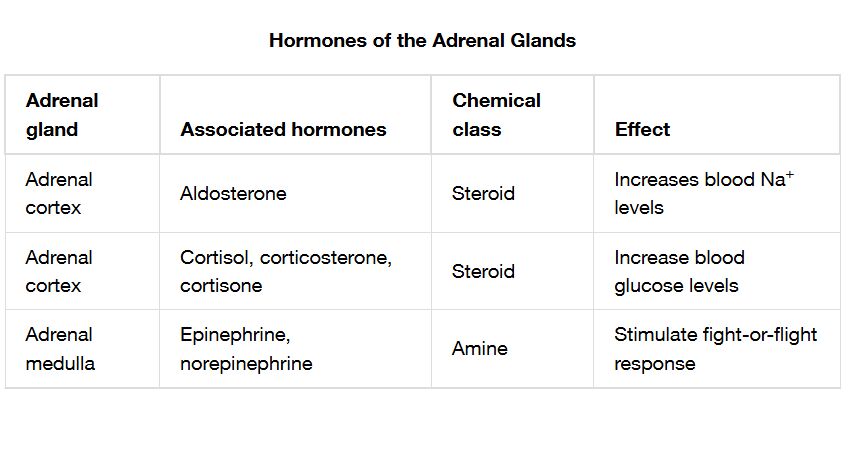The adrenal glands, perched atop the kidneys, are vital endocrine organs that produce hormones essential for stress response, metabolism, and electrolyte balance. This article explores a detailed chart outlining the hormones secreted by the adrenal glands, their release mechanisms, and their physiological effects, offering a comprehensive look at their role in maintaining bodily homeostasis.

Adrenal cortex The adrenal cortex, the outer layer of the adrenal gland, produces steroid hormones critical for metabolism and stress response. It is divided into zones, each responsible for specific hormone synthesis.
Adrenal medulla The adrenal medulla, the inner core, releases catecholamines like adrenaline and noradrenaline during stress. It responds rapidly to nervous system signals for the fight-or-flight response.
Zona glomerulosa The zona glomerulosa, the outermost cortical zone, produces aldosterone to regulate sodium and potassium balance. It is primarily controlled by the renin-angiotensin-aldosterone system.
Zona fasciculata The zona fasciculata, the middle cortical layer, synthesizes cortisol to manage stress and metabolism. Its secretion is stimulated by adrenocorticotropic hormone (ACTH) from the pituitary.
Zona reticularis The zona reticularis, the innermost cortical zone, produces androgens that contribute to secondary sexual characteristics. These hormones are released in smaller amounts compared to other cortical hormones.
Aldosterone Aldosterone promotes sodium reabsorption and potassium excretion in the kidneys, maintaining blood pressure and fluid balance. Its release is triggered by low sodium or high potassium levels.
Cortisol Cortisol regulates metabolism, reduces inflammation, and aids in stress response by increasing blood sugar levels. It follows a diurnal rhythm, peaking in the morning.
Androgens Androgens from the adrenal cortex, such as dehydroepiandrosterone (DHEA), support the development of secondary sexual traits and are converted to testosterone or estrogen. Their production is minimal compared to gonadal sources.
Adrenaline (epinephrine) Adrenaline, released by the adrenal medulla, prepares the body for acute stress by increasing heart rate and energy availability. It acts quickly via the sympathetic nervous system.
Noradrenaline (norepinephrine) Noradrenaline, also from the adrenal medulla, supports blood pressure regulation and stress response. It works alongside adrenaline to enhance the fight-or-flight reaction.
Effects Effects of adrenal hormones include metabolic regulation, electrolyte balance, and stress adaptation. These outcomes vary based on the hormone and physiological context.
Anatomical Structure of the Adrenal Glands
The adrenal glands consist of distinct regions with specialized functions. This division enables a range of hormonal responses to bodily needs.
- The adrenal cortex produces steroid hormones in three zones: glomerulosa, fasciculata, and reticularis.
- The adrenal medulla releases catecholamines for immediate stress reactions.
- The glands sit atop the kidneys, ensuring proximity to the bloodstream.
- Each zone’s unique structure supports its specific hormone production.
- This anatomical layout enhances the glands’ efficiency.
Hormone Production in the Adrenal Cortex
The adrenal cortex’s zones synthesize hormones with diverse roles. Their production is tightly regulated to meet physiological demands.
- The zona glomerulosa secretes aldosterone to control sodium and potassium.
- The zona fasciculata produces cortisol, key for stress and energy metabolism.
- The zona reticularis releases androgens, contributing to sexual development.
- ACTH from the pituitary stimulates cortisol and androgen production.
- The renin-angiotensin system drives aldosterone release.
Functions of Adrenal Medulla Hormones
The adrenal medulla provides rapid hormonal responses to stress. Its catecholamines are essential for survival mechanisms.
- Adrenaline increases heart rate and mobilizes glucose for energy.
- Noradrenaline constricts blood vessels, raising blood pressure.
- Both hormones are released via sympathetic nervous stimulation.
- Their effects are short-lived but intense during emergencies.
- This response prepares the body for immediate action.
Physiological and Clinical Significance
Adrenal hormones play a critical role in maintaining homeostasis and responding to stress. Imbalances can lead to notable health conditions.
- Aldosterone excess can cause hypertension due to sodium retention.
- Low cortisol levels result in Addison’s disease, with fatigue and weakness.
- High cortisol, as in Cushing’s syndrome, leads to weight gain and diabetes risk.
- Adrenaline overproduction may contribute to anxiety or palpitations.
- Blood tests and imaging assess hormone levels for diagnosis.
The adrenal glands’ hormones, from the cortex’s aldosterone and cortisol to the medulla’s adrenaline and noradrenaline, orchestrate a complex system that supports metabolism, stress response, and electrolyte balance. Understanding their release and effects provides insight into their essential role in health, as well as the potential impact of disorders like Addison’s disease or Cushing’s syndrome, guiding effective clinical management.

